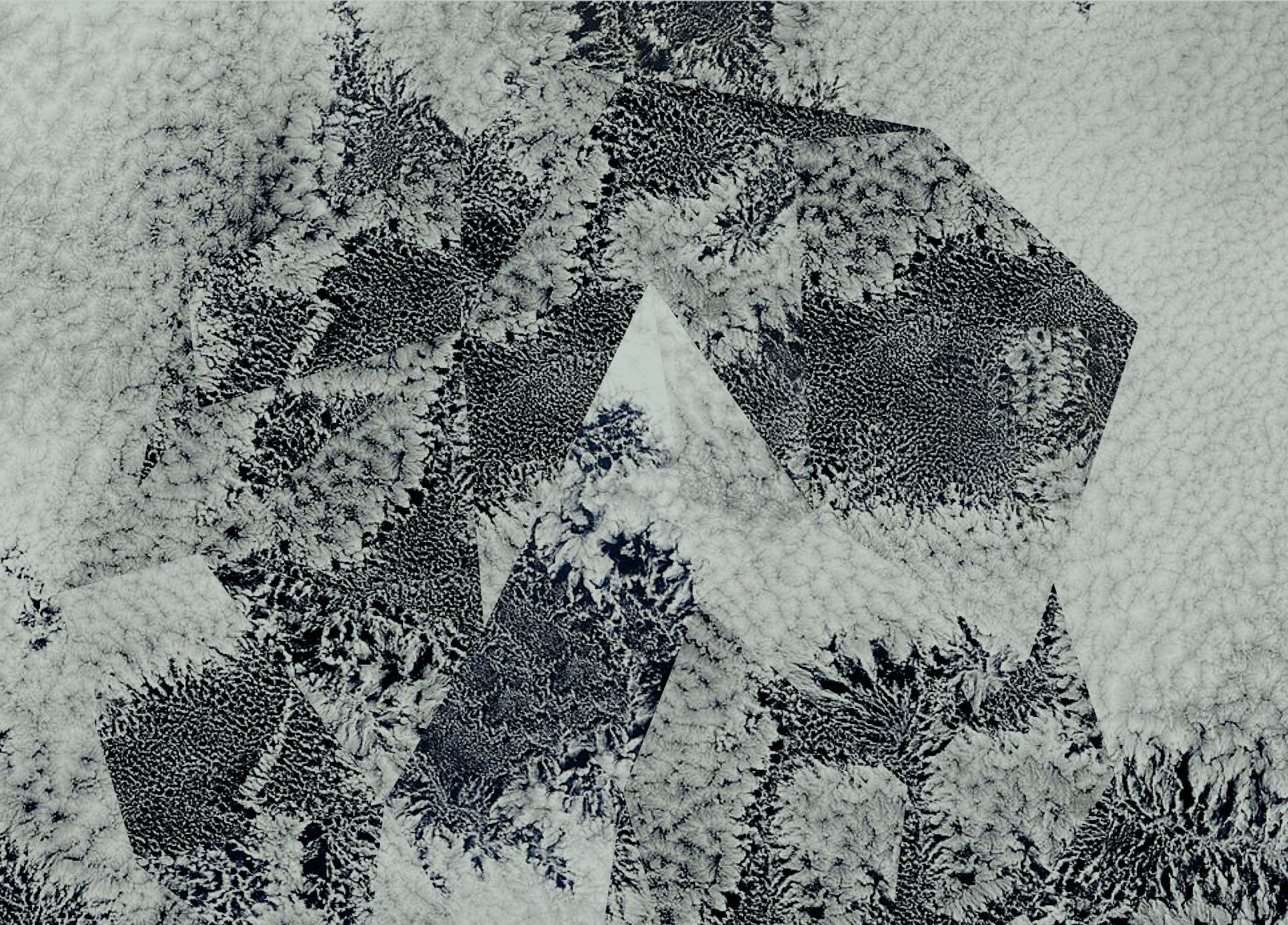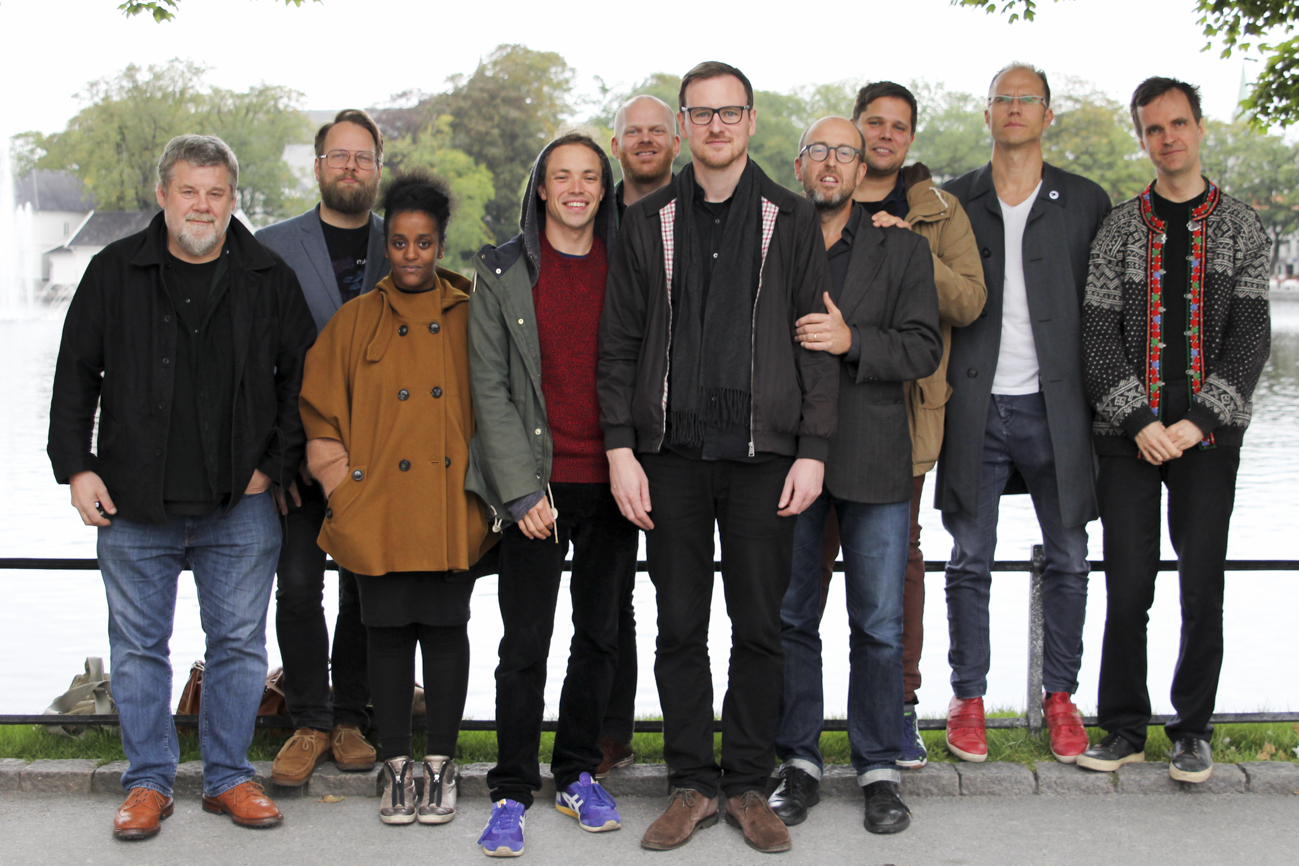
Bandleadership
When I named this project ”Natural Patterns – Music making with an ensemble of improvisers”, using the word ”with” in stead of ”in” (an ensemble), I not only wanted to say something about the contribution from the improvisers, but also something about my dual position as the band leader and ensemble musician. It’s not a collective of free improvisers where we improvise the music together. This is my music in the sense that I create the meeting points where the musicians insert their personal material, and influence and communicate with each other, and because I am the leader and administrator of the ensemble.
In a classical orchestra there is a clear hierarchy, with the conductor on top, the group leaders next, and the rest of the musicians at the bottom. In most freely improvising ensembles, there is, in theory, none. Yet, most large ensembles playing free improvisation seem to need a kind of leader or instigator to not disintegrate. Also, when someone has gone to the trouble of assembling a large improvising ensemble, one seems to automatically assume that he or she has a strong idea of or wish for the sounding result.
Another hierarchical aspect can be present as well in free improvisation: The more experienced improvisers, or at least those who consider themselves as such, will sometimes command more respect, either consciously or subconsciously, compared to the less experienced ones. This can result in less flow in the music, people becoming too timid or too brash, and personal conflicts in the group.
The same goes for notation. If I give too much instructions or too detailed notation, there is a point where even extremely strong improvisers will become less assertive, and turn into a more passive interpreter of my musical ideas. The balance is skewed and hierarchy is established, and the result is a blander music, where neither my intentions as composer or the voice of the improviser comes out. I can almost sense the musician turning into an instrument with less power of intention, due to too constricting leadership.
Flow
My experience is that he improviser needs to be given space to play and to feel calm, safe and focused when improvising. The material the improviser works with has to provide this, not add pressure, which is what I aimed to do with the Li.
This does not necessarily mean giving the player as much freedom as possible at all times, but rather not stressing the players too much. The improviser has to be able to focus on the totality of the sound, and their own contribution to the sound and musical situation, without having to focus too much on notation or other predetermined material which makes them having to divide their focus, or that makes them uncomfortable.
The ideal is to be able to achieve a state of Flow as often as possible when improvising, where the challenge suits the skill of the person at all times.
In my music, I believe that it’s possible to achieve this feeling of relaxed focus together with predetermined composed material, as long as we do not have to make too many choices regarding the macro form of a piece while improvising. As in transitions between improvised and notated material, for example: Notated predetermined material in my music is normally only introduced by musicians who are not improvising at the moment. This way, we can focus completely on the improvisation, with the knowledge that one has complete control over what happens in that moment. Notated material could be played by improvisers after an improvisation, though, when it is clear that the improvisation has definitely ended, like a start of a new section, or as a cue for a transition.
Atmosphere
Another important aspect of this need of a stress free environment (or exactly the right amount of stress) is visible in the rehearsal situation. In a context where the music depends on correct execution and interpretation of notated compositions, for example in a classical orchestra, it is, in theory, possible to do a decent job even if the atmosphere is hostile. In an ensemble like the PZE, a bad atmosphere due to conflicts between myself as the leader or between the musicians makes the music suffer. It becomes less creative, and one resorts to clichees to just get the music done, and escape the situation.
Rehearsal strategies
A main task for me as the band leader, in the fragile social and musical construct of the ensemble of improvisers, is thus to manage the group dynamics of the ensemble. In a large group, some will be more timid, some will be bored, feeling like they are not being heard, and some will command a lot of attention. People also have different aesthetics and opinions about my (and others’) musical ideas. This can lead to conflicts or ineffective work.
Throughout the project I have worked on my own communication skills, trying to both verbally and physically communicate in a way that makes every musician feel like they are being heard and appreciated. Trying to resolve conflicts, encourage verbal and musical dialogue (which also the Li were important tools for), and making sure that the atmosphere stays light (or at least bearable), and that everyone feels involved.
Rehearsal strategies are often tacit or non-existent in the average improvising ensemble.
I would therefore also consider, after each cycle with the large ensemble, what kind of rehearsal methods were most effective: A combination of Li with some predetermined material and free improvisations to focus the ensemble now and then? Working on sections or entire forms to get an overview? Warming up by improvising together or help concentration by delving into something concrete?
Now, finding one clear answer to this seems difficult, and different strategies work better at different times in the process. I see it rather as an accumulation of tacit knowledge, where i sense how the ensemble responds to me and the various rehearsal strategies I try out, allowing me to adjust my ways of working from cycle to cycle, gradually finding a way that works for this specific ensemble.
Placement and listening
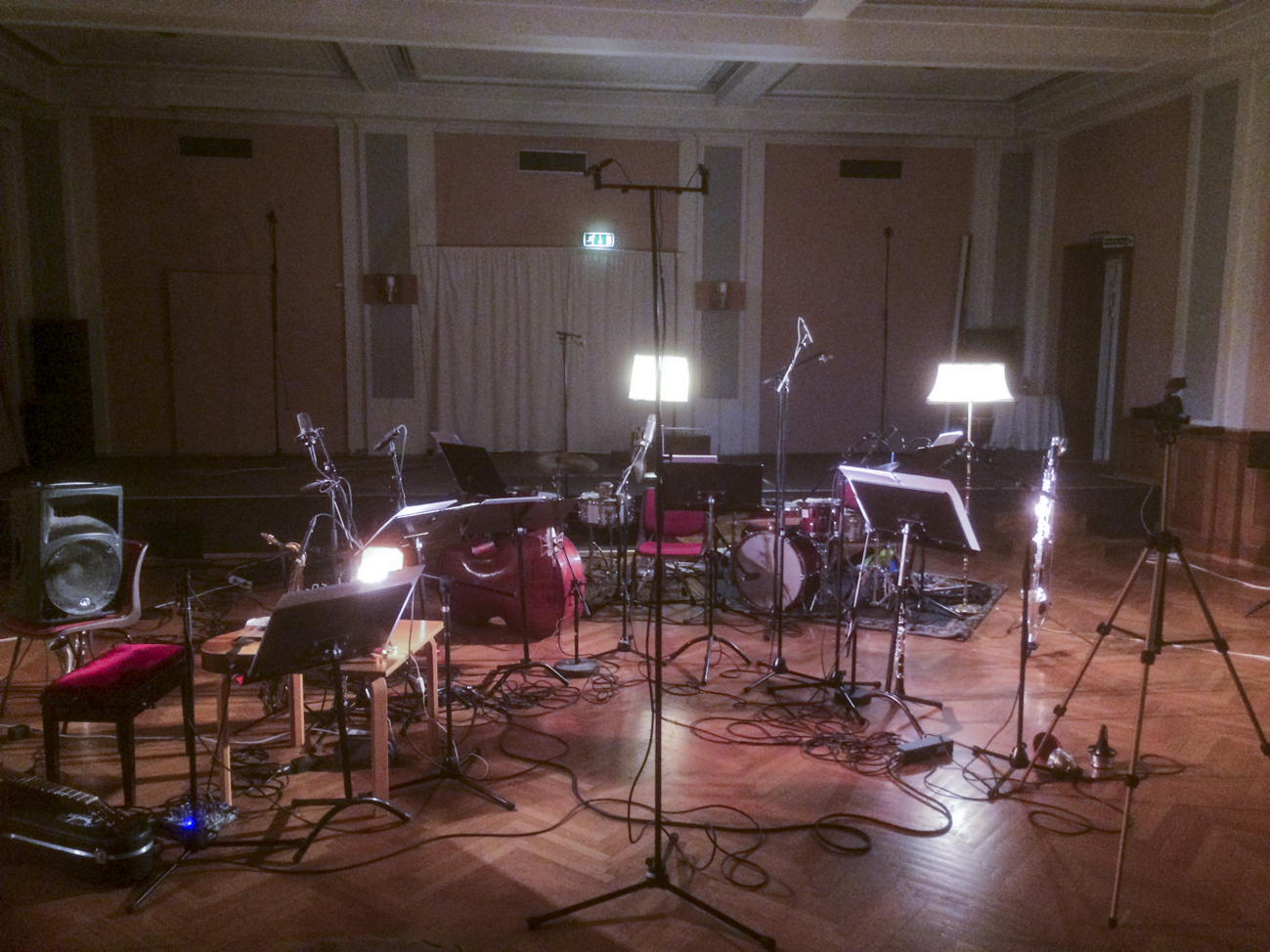
Throughout the period of working with the PZE I have also constantly searched for the optimal placement of the musicians. The listening situation, and thus the music, is greatly influenced by a number of factors:
Amplification
Ivar Grydeland describes his experience with PA systems, in a way I can relate to:
PA systems alter the playing situation on stage. Not only does it change the dynamics. If it is loud, it can almost eliminate the dynamic range of the instruments. Everything is big. Small details get big. The instruments sound bigger and larger in the hall than they do on stage. I sometimes listen to the other instruments, and my own instrument via the room, via the PA system, not directly on stage. So much of what we do is about proximity. That the sounds we play are near us, between us and that they coalesce and form composites near us. This disappears a little with a PA system. This, needless to say, changes the communication on stage. A PA system is such a heavy and dominant filter that it has to be considered as a 5th member of our group. (Grydeland 2016)
We normally play acoustically in the PZE, except for the occasional AudioLi electronics and some light amplification of the acoustic guitar. This way of working seems to give a more realistic and dynamic interplay situation. If we do use a PA system, I try to limit it to giving an almost inaudible lift of the softer sounds, to help in rooms with dry acoustics.
Listening and dynamics
The ideal is that everyone can hear each other at all times. This is of course dependent on the musicians playing louder instruments adjusting to the ones with a lower volume. Yet, I still want the music to have as wide a dynamic range as possible, where the peaks are allowed to be fairly loud.
Cueing
1
Visual contact between the musicians is also important, even if the main way of communication is through sound. Some parts of the compositions have visual cues, where I, or someone else in the group, will indicate when to start or stop a certain material.
I have aimed to distribute this visual cueing throughout the ensemble, to avoid a hierarchical situation where one person becomes the leader at all times. I also try to keep visual cues to a minimum.
2
I discovered that sound cues are more conducive to listening, and that this allows the musicians to start new sections or end what they are doing in a more musical, listening way. This sound-based way of cueing helps the large ensemble organize and find equilibrium much like the way a smaller ensemble works. In a smaller ensemble mixing predetermined material and improvisation, like a free jazz group playing tunes, for example, a hint of a melody can be enough to make the whole group instantly start playing a unison melodic line.
In a larger ensemble, the chance of this succeeding is much smaller, I think, especially when there is a written score involved. This, again, has to do with the cognitive discrepancy between reading and listening/playing. My sound-based cues can be the audioLi starting or stopping, a group entering and playing something contrasting, a change in a process (from pitch to noise, for example), someone changing dynamics and so on.
Physical Placement
1
All of the above elements are greatly influenced by the placement of the musicians on stage, and has a strong influence on the musical results, since listening possibly is the most important feature of improvised music (and musicking in general). Improvisation, and being able to contribute something meaningful to the musical situation, depends on being able to focus on the total sound of the music. If your focus is on trying to hear what the others are doing, this becomes impossible, and you don’t feel safe and relaxed in the way one needs to contribute creatively.
I have experimented with various ways of setting up the large ensemble throughout the period, trying to ensure that everyone has the optimal conditions in most performance spaces. As an improviser, the ideal listening situation is to hear everyone equally well.
When you are seated next to a loud instrument, and yours is loud too (for example a sax next to a sax), there is a tendency to try to match each others volume, leading to a general increase.
In the beginning, I tried placing sax players away from each other, drums on different sides and so on, i.e not mixing louder instrument groups. I also tried to keep musicians who tended to play mostly with certain others (i.e. listen to certain people more than others), away from them.
At some point I started trying to use these tendencies in the compositions in stead of working against them, for example using instrument groups together and already established groups within the ensemble.
2
In addition to the aural well-being and balancing the voices of everyone taking part in the ensemble, I have another motive for this focus on the physical layout of the group.
I think about the ensemble in a two or three-dimensional way, with an axis from left to right and one from the back to the front. The third dimension, from low to high, usually is expressed more in a register sense, but the two others I use in various ways : The way the ensemble is split into groups, which can be either close, far away from each other, on various points of both axes, in how phrases are distributed, either through notated ”spatial” exercises, two groups playing ”against” each other on different sides of the axis, or through verbal instructions on pauses in Li-textures. This can, sometimes, result in beautiful sound spaces where sounds come from different places in interesting ways.
3
A method for thinking about these issues in the preparation part of the cycle, has been to make diagrams of the ensemble, seeing possibilities for combinations and movements in the ensemble on paper, and then trying them out in rehearsal.
-The combinations are based on proximity in the ensemble, which makes improvisation and interplay easier,
-my ideas of who would sound good improvising together,
-sound movements along the axes,
-certain instrumentation groups (percussion, winds, strings and so on),
-harmonic/chordal movements
-preexisting groups within the ensemble
The physical placement is changed on a regular basis, after rehearsals or concerts where I see that the listening suffers on some level, and in situations where I try a ”spatial” or group idea which does not work the way I wanted.
4
Here is an example of a diagram where I have outlined several smaller, preexisting groups or possible new groups in the ensemble.
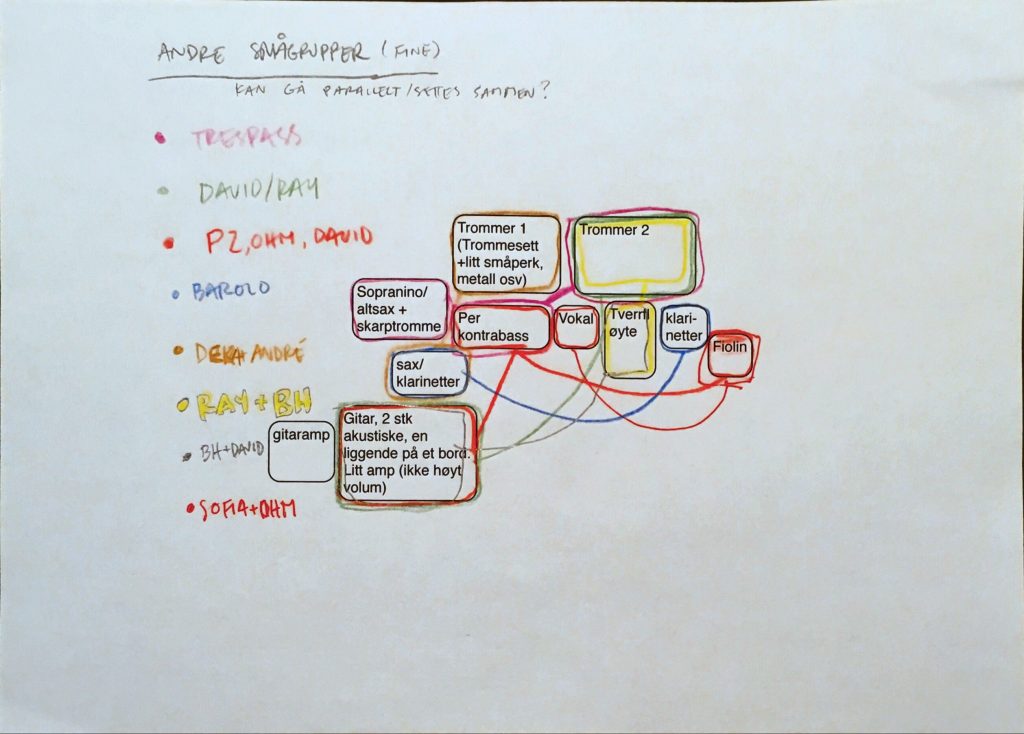
In this diagram I have outlined duo possibilities based on proximity.
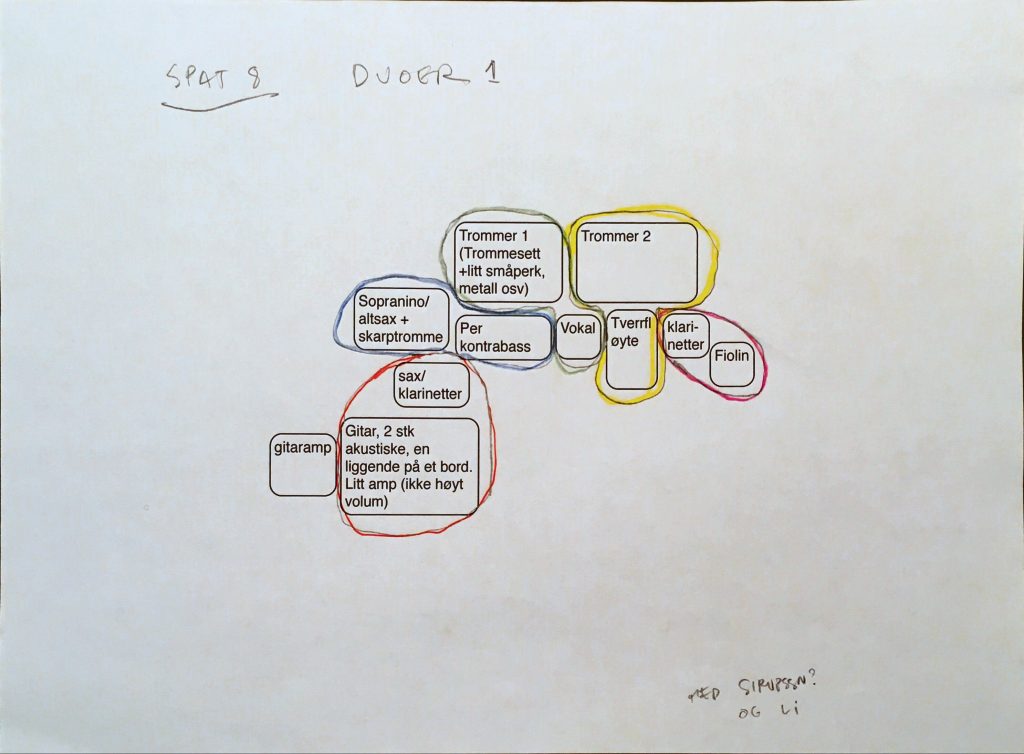
Here is an example of a diagram where I have outlined two possible ”opposing” larger groups to use in the Breaking-Li.
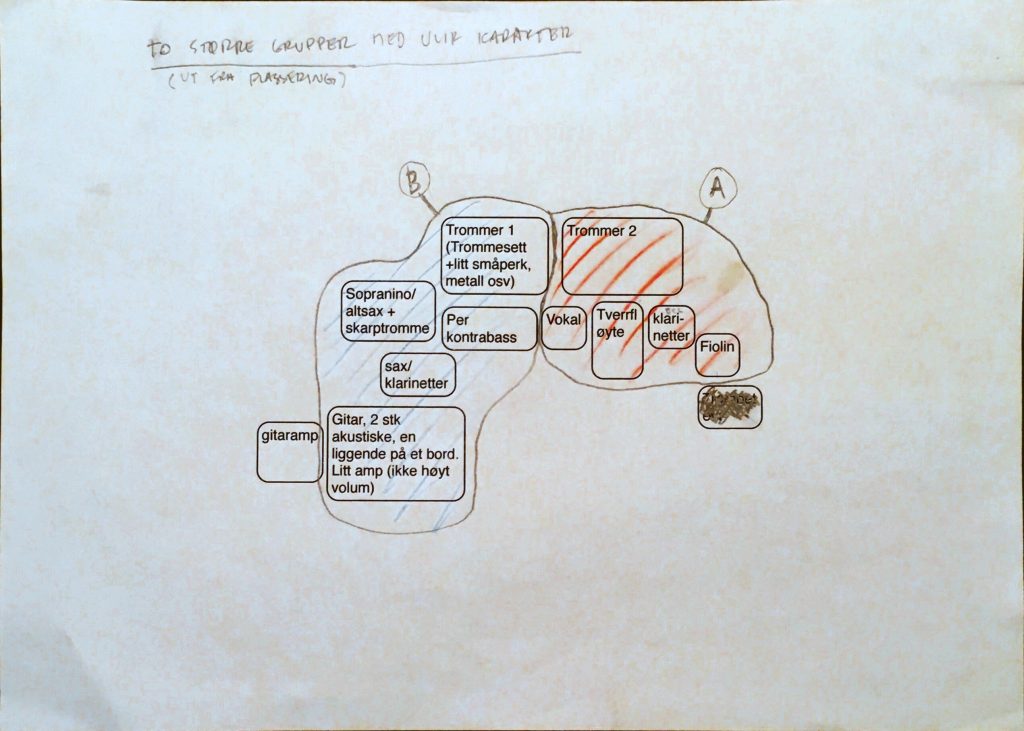
This diagram shows a few possible trios for the piece Li 3
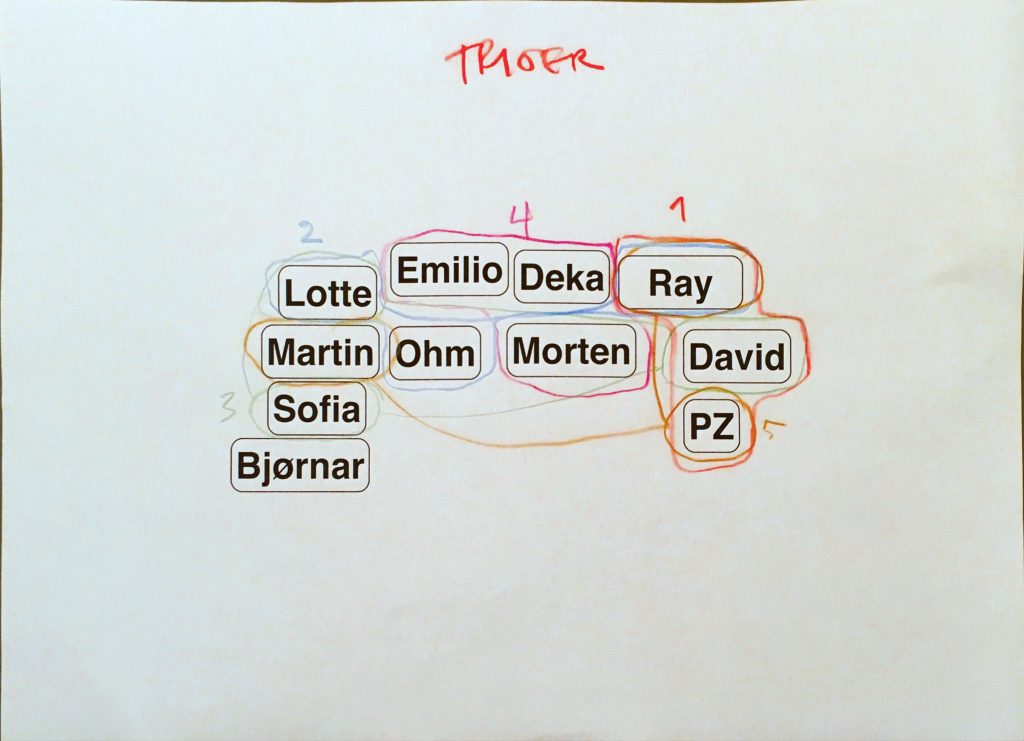
Here is an example of an exercise/etude created to make a pointillistic (Spots) movement in the ensemble, and to work on our ability to listen and play spatially during improvisations.
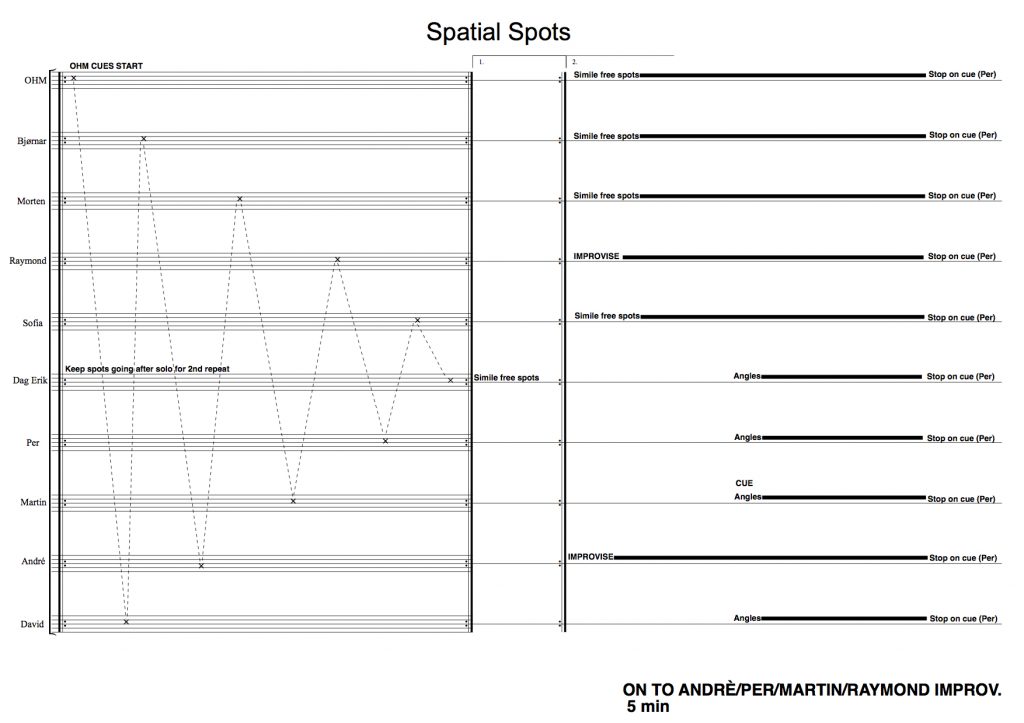
This is a part of a similar exercise/etude created to see what it feels like to make a slow, sustained movement in the ensemble :
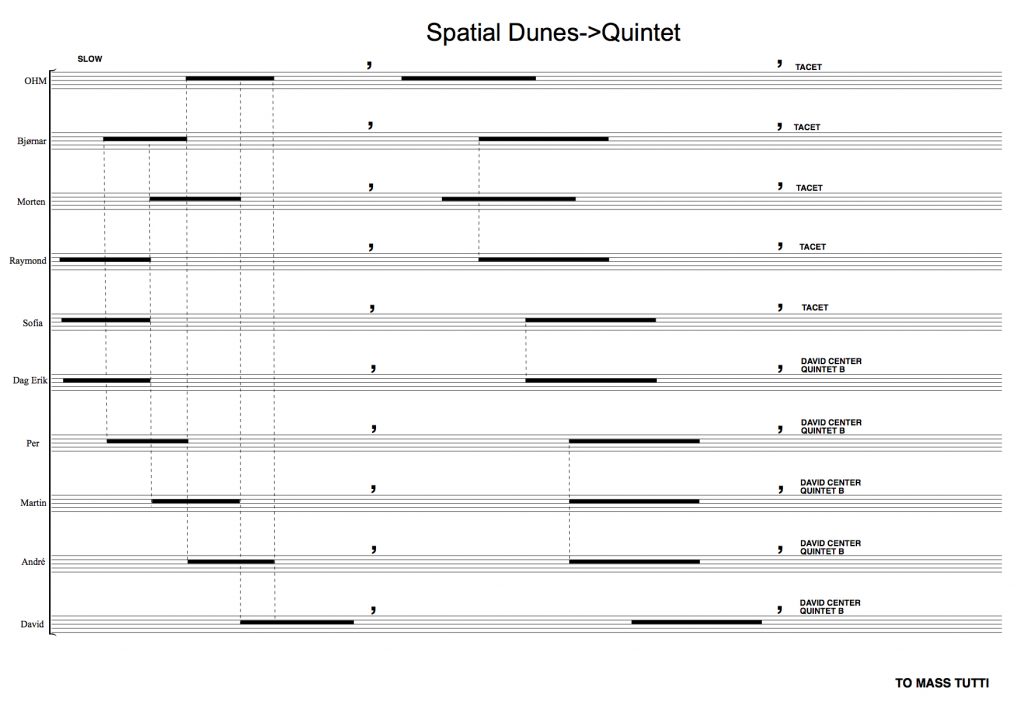
Acoustics
Acoustics and the context we play in are important factors, to a certain degree determining how the final musical result ends up. Improvisation is site-specific.
Evan Parker talks about how he can use a certain, more high energy and direct way of improvising that he knows will communicate better in for example noisy festivals. (Parker 1987)
I definitely got this feeling when we played the Kongsberg Jazz Festival with the PZE. There is something restless and frenetic about the way we play most of the piece. Maybe we aim for high energy, or maybe it’s just the fact that we are playing in a well known jazz festival, and we subconsciously don’t want to bore the festival audience? Or maybe we were a little nervous for the same reason?
Score: Li 2 Kongsberg 2016

Photo: Kjetil Møster
Playing at Bergen Kjøtt gave me another clear experience of how the context colours the music. We played a concert in the middle of a textile exhibition by Hildur Bjarnadottir.
Textiles were hanging from the ceiling, making a quite special atmosphere.
The room has a quite long reverb, and this changed the music. From a rather aggressive version at a smaller club in Oslo the day before, into a much more listening and contemplative mood in general. The long reverb made it impossible to hear anything if you play too much or too loud, and in this case luckily we reacted by listening even more.
Balance
Naming the ensemble the Per Zanussi Ensemble, seems to be a clear indication that this is not really a collective of improvisers. The main reason I chose to use this name is the research context of the project. I wanted to signal that this is my project, where I explore my ideas about composing with improvisers. This may suggest to the musicians that we are not really equals, and undermine the idea of creating a culture within the ensemble, making feelings of ownership towards the music weaker.
I do think this is problematic, improvisation wise, and I have considered changing the name into something which suggests a more collective approach in the future. I also think Simon Fell has a point in his article ”A More Attractive Way of Getting Things Done: Some Questions of Power and Control in British Improvised Music” (Fell 2015), where he suggests that the best way of organizing a large ensemble may be to let all the musicians take turns leading artistically.
On the other hand I do think someone has to be an administrative, instigating force to be able to make ensembles of this size survive over time, and I think most projects of this size historically (with some great exceptions) have happened because one person has had a burning wish to see his or her ideas realized.
The project has circled around the two sides of my musical personality: The composer and the improviser. What I have said about the improvisers in the ensemble has also been true for my role as an improviser.
However, juggling my roles in the ensemble can be a challenge, compared to how I experience improvising in a smaller group or someone else’s larger ensemble.
At a concert with the PZE, at first I will be more nervous than I usually am. Then, when I realize that things are going well (with everyone else in the ensemble too), I will be more at ease, but my focus is still constantly split between my own playing and making sure everyone is in control of their tasks.
After a while, an ”improvisational fatigue” (worse than in a setting where I have a freer role) sets in, and sometimes these different approaches seem impossible to balance. It feels easier for me to set up experiments and work on the music outside the rehearsal room, where I don’t have to relate to the chaos and challenges of the real world (i.e the other musicians). Yet, I know that the ”real” music only happens in relation to the others, playing and discussing together.
